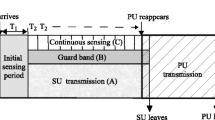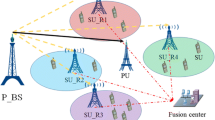Abstract
One of the most efficient methods to reduce the dropping and blocking probabilities of the secondary users (SUs) in cognitive radio networks is channel sub-banding strategy. This means that when all the channels are occupied by the primary and secondary users, then the SUs’ channels can be divided into two sub-bands, and two SUs can use a sub-band, simultaneously. In this paper, we propose an opportunistic spectrum sharing system in cognitive radio networks in which, the channel sub-banding strategy is implemented. Furthermore, we describe the problem of channel sub-banding considering the spectrum sensing errors such as false alarm and miss-detection events for both initial and on-going SUs’ calls. Due to unreliable spectrum sensing by the SUs and subsequently possible interference with the primary users, we assume that both primary and secondary users may lose the channel due to the collision. The proposed model is analyzed by a two-dimensional Markov chain model and for performance evaluation, metrics such as blocking and dropping probabilities and channel utilization are derived. Numerical and simulation results show the accuracy of the proposed model which can be used in the evaluation of future cognitive radio networks’ performance.








Similar content being viewed by others
References
McHenry, M. (2003). Frequency agile spectrum access technologies. In Proceeding of FCC Workshop on Cognitive Radio, Washington.
Staple, G., & Werbach, K. (2004). The end of spectrum scarcity. IEEE Spectrum, 41(3), 48–52.
Akyildiz, I. F., Lee, W. Y., Vuran, M. C., & Mohantly, S. (2006). Next generation/ dynamic spectrum access/cognitive radio wireless network: a survey. Computer Networks, 50, 2127–2159.
Attar, A., Ghorashi, S. A., Sooriyabandara, M., & Aghvami, A. H. (2008). Challenges of real-time secondary usage of spectrum. Computer Networks Journal, Special Issue on Cognitive Wireless Networks, 52(4), 816–830.
Mitola, J. (2000). Cognitive radio: an integrated agent architecture for software defined radio. PhD. Thesis, KTH Royal Institute of Technology, Stockholm, Sweden.
ThiHong, C. P., Kang, H. S., & Koo, I. (2010). An efficient radio resource management scheme for cognitive radio networks. ICIC’10 Proceedings of the Advanced intelligent computing theories and applications (pp. 376–383).
Kumar, S., Sahay, J., Mishra, G. K., & Kumar, S. (2011). Cognitive radio concept and challenges in dynamic spectrum access for the future generation wireless communication systems. Wireless Personal Communications, 59(3), 525–535.
Zhao, Q., & Sadler, B. M. (2007). A survey of dynamic spectrum access. IEEE Signal Processing Magazine, 24(3), 79–89.
Budiarjo, I., Lakshmanan, M. K., & Nikookar, H. (2008). Cognitive radio dynamic access techniques. Wireless Personal Communications, 45(3), 293–324.
Leu, A. E., McHenry, M., & Mark, B. L. (2006). Modeling and analysis of interference in listen-before-talk spectrum access schemes. International Journal of Network Management, 16(2), 131–147.
Tang, S., & Mark, B. L. (2007). Performance analysis of a wireless network with opportunistic spectrum sharing. in Proceeding of IEEE Globecom’07 (pp. 4636–4640).
Tang, S., & Mark, B. L. (2009). Modeling and analysis of opportunistic spectrum sharing with unreliable spectrum sensing. IEEE Transaction on wireless communication, 8(4), 1934–1943.
Tang, S. (2010). Performance modeling of an opportunistic spectrum sharing wireless network with unreliable sensing, In Proceeding of IEEE (ICNSC) (pp. 101–106).
Tang, S. (2013). Reconnection analysis for a cognitive radio network with unreliable sensing. Wireless Personal Communications, 69(1), 299–305.
Geirhofer, S., Tong, L., & Sadler, B. (2006). A measurement-based model for dynamic spectrum access in WLAN channels. In Proceeding of IEEE MILCOM’06 (pp. 1–7).
Hosseini, S. M., Teimouri, M., & Nadarajah, S. (2012). Available and Waiting Times for Cognitive Radios. Wireless Personal Communications, 65(2), 319–334.
Jiao, L., Pla, V., & Li, F. Y. (2010). Analysis on channel bonding/aggregation for multi-channel cognitive radio networks. IEEE European Wireless Conference, (pp. 468–474), Lucca.
Lee, J., & So, J. (2010). Analysis of cognitive radio networks with channel aggregation. in proceedings of WCNC (pp. 1–6).
Zhu, X., Shen, L., & Yum, T. S. P. (2007). Analysis of cognitive radio spectrum access with optimal channel reservation. IEEE Commununication Letters, 11(4), 304–306.
Tang, P. K., Chew, Y. H., Ong, L. C., & Haldar, M. K. (2006). Performance of secondary radios in spectrum sharing with prioritized primary access. In Proceedings IEEE Military Communication Conference (pp. 1–7).
Kalil, M. A., Al-Mahdi, H., & Mitschele-Thiel, A. (2009). Analysis of opportunistic spectrum access in cognitive ad hoc networks. Analytical and Stochastic Modeling Techniques and Applications, Lecture Notes in Computer Science., 5513, 16–28.
Gavrilovska, L., & Atanasovski, V. (2011). Spectrum sensing framework for cognitive radio networks. Wireless Personal Communications, 59(3), 447–469.
Fang, Y., Lin, Y. B., & Chlamtac, I. (1998). Channel occupancy times and hand-off rate for mobile computing and PCS networks. IEEE Transaction on Computers., 47(6), 679–692.
Author information
Authors and Affiliations
Corresponding author
Rights and permissions
About this article
Cite this article
Homayouni, S., Ghorashi, S.A. Sub-banding the Secondary Users’ Channel in Cognitive Radio Networks Considering Unreliable Spectrum Sensing. Wireless Pers Commun 77, 1129–1143 (2014). https://doi.org/10.1007/s11277-013-1558-1
Published:
Issue Date:
DOI: https://doi.org/10.1007/s11277-013-1558-1




